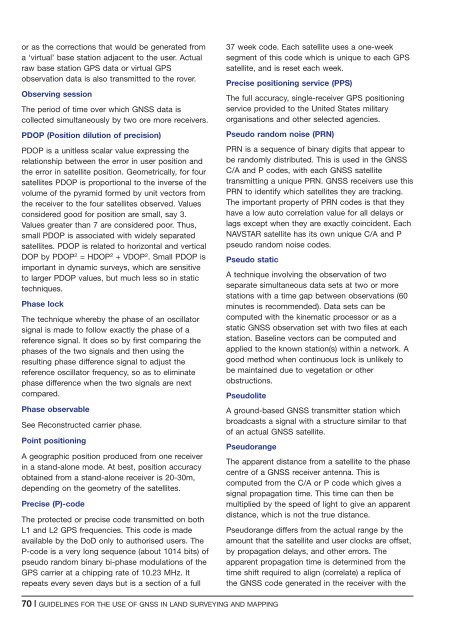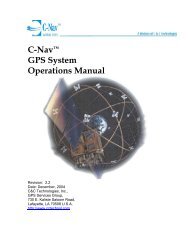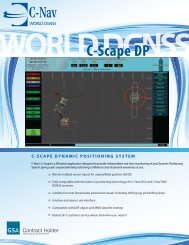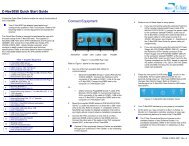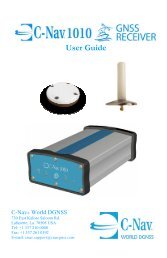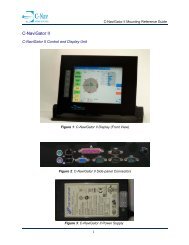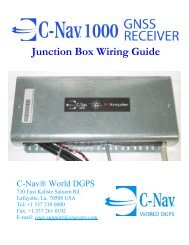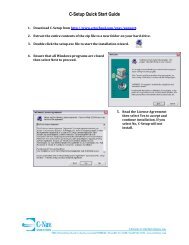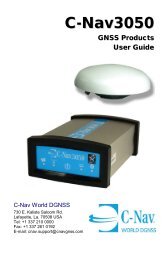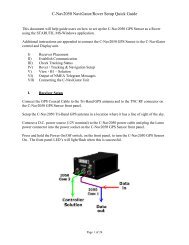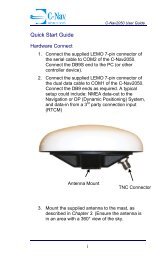Guidelines for the use of GNSS in surveying and mapping
Guidelines for the use of GNSS in surveying and mapping
Guidelines for the use of GNSS in surveying and mapping
Create successful ePaper yourself
Turn your PDF publications into a flip-book with our unique Google optimized e-Paper software.
or as <strong>the</strong> corrections that would be generated from<br />
a ‘virtual’ base station adjacent to <strong>the</strong> <strong>use</strong>r. Actual<br />
raw base station GPS data or virtual GPS<br />
observation data is also transmitted to <strong>the</strong> rover.<br />
Observ<strong>in</strong>g session<br />
The period <strong>of</strong> time over which <strong>GNSS</strong> data is<br />
collected simultaneously by two ore more receivers.<br />
PDOP (Position dilution <strong>of</strong> precision)<br />
PDOP is a unitless scalar value express<strong>in</strong>g <strong>the</strong><br />
relationship between <strong>the</strong> error <strong>in</strong> <strong>use</strong>r position <strong>and</strong><br />
<strong>the</strong> error <strong>in</strong> satellite position. Geometrically, <strong>for</strong> four<br />
satellites PDOP is proportional to <strong>the</strong> <strong>in</strong>verse <strong>of</strong> <strong>the</strong><br />
volume <strong>of</strong> <strong>the</strong> pyramid <strong>for</strong>med by unit vectors from<br />
<strong>the</strong> receiver to <strong>the</strong> four satellites observed. Values<br />
considered good <strong>for</strong> position are small, say 3.<br />
Values greater than 7 are considered poor. Thus,<br />
small PDOP is associated with widely separated<br />
satellites. PDOP is related to horizontal <strong>and</strong> vertical<br />
DOP by PDOP 2 = HDOP 2 + VDOP 2 . Small PDOP is<br />
important <strong>in</strong> dynamic surveys, which are sensitive<br />
to larger PDOP values, but much less so <strong>in</strong> static<br />
techniques.<br />
Phase lock<br />
The technique whereby <strong>the</strong> phase <strong>of</strong> an oscillator<br />
signal is made to follow exactly <strong>the</strong> phase <strong>of</strong> a<br />
reference signal. It does so by first compar<strong>in</strong>g <strong>the</strong><br />
phases <strong>of</strong> <strong>the</strong> two signals <strong>and</strong> <strong>the</strong>n us<strong>in</strong>g <strong>the</strong><br />
result<strong>in</strong>g phase difference signal to adjust <strong>the</strong><br />
reference oscillator frequency, so as to elim<strong>in</strong>ate<br />
phase difference when <strong>the</strong> two signals are next<br />
compared.<br />
Phase observable<br />
See Reconstructed carrier phase.<br />
Po<strong>in</strong>t position<strong>in</strong>g<br />
A geographic position produced from one receiver<br />
<strong>in</strong> a st<strong>and</strong>-alone mode. At best, position accuracy<br />
obta<strong>in</strong>ed from a st<strong>and</strong>-alone receiver is 20-30m,<br />
depend<strong>in</strong>g on <strong>the</strong> geometry <strong>of</strong> <strong>the</strong> satellites.<br />
Precise (P)-code<br />
The protected or precise code transmitted on both<br />
L1 <strong>and</strong> L2 GPS frequencies. This code is made<br />
available by <strong>the</strong> DoD only to authorised <strong>use</strong>rs. The<br />
P-code is a very long sequence (about 1014 bits) <strong>of</strong><br />
pseudo r<strong>and</strong>om b<strong>in</strong>ary bi-phase modulations <strong>of</strong> <strong>the</strong><br />
GPS carrier at a chipp<strong>in</strong>g rate <strong>of</strong> 10.23 MHz. It<br />
repeats every seven days but is a section <strong>of</strong> a full<br />
37 week code. Each satellite <strong>use</strong>s a one-week<br />
segment <strong>of</strong> this code which is unique to each GPS<br />
satellite, <strong>and</strong> is reset each week.<br />
Precise position<strong>in</strong>g service (PPS)<br />
The full accuracy, s<strong>in</strong>gle-receiver GPS position<strong>in</strong>g<br />
service provided to <strong>the</strong> United States military<br />
organisations <strong>and</strong> o<strong>the</strong>r selected agencies.<br />
Pseudo r<strong>and</strong>om noise (PRN)<br />
PRN is a sequence <strong>of</strong> b<strong>in</strong>ary digits that appear to<br />
be r<strong>and</strong>omly distributed. This is <strong>use</strong>d <strong>in</strong> <strong>the</strong> <strong>GNSS</strong><br />
C/A <strong>and</strong> P codes, with each <strong>GNSS</strong> satellite<br />
transmitt<strong>in</strong>g a unique PRN. <strong>GNSS</strong> receivers <strong>use</strong> this<br />
PRN to identify which satellites <strong>the</strong>y are track<strong>in</strong>g.<br />
The important property <strong>of</strong> PRN codes is that <strong>the</strong>y<br />
have a low auto correlation value <strong>for</strong> all delays or<br />
lags except when <strong>the</strong>y are exactly co<strong>in</strong>cident. Each<br />
NAVSTAR satellite has its own unique C/A <strong>and</strong> P<br />
pseudo r<strong>and</strong>om noise codes.<br />
Pseudo static<br />
A technique <strong>in</strong>volv<strong>in</strong>g <strong>the</strong> observation <strong>of</strong> two<br />
separate simultaneous data sets at two or more<br />
stations with a time gap between observations (60<br />
m<strong>in</strong>utes is recommended). Data sets can be<br />
computed with <strong>the</strong> k<strong>in</strong>ematic processor or as a<br />
static <strong>GNSS</strong> observation set with two files at each<br />
station. Basel<strong>in</strong>e vectors can be computed <strong>and</strong><br />
applied to <strong>the</strong> known station(s) with<strong>in</strong> a network. A<br />
good method when cont<strong>in</strong>uous lock is unlikely to<br />
be ma<strong>in</strong>ta<strong>in</strong>ed due to vegetation or o<strong>the</strong>r<br />
obstructions.<br />
Pseudolite<br />
A ground-based <strong>GNSS</strong> transmitter station which<br />
broadcasts a signal with a structure similar to that<br />
<strong>of</strong> an actual <strong>GNSS</strong> satellite.<br />
Pseudorange<br />
The apparent distance from a satellite to <strong>the</strong> phase<br />
centre <strong>of</strong> a <strong>GNSS</strong> receiver antenna. This is<br />
computed from <strong>the</strong> C/A or P code which gives a<br />
signal propagation time. This time can <strong>the</strong>n be<br />
multiplied by <strong>the</strong> speed <strong>of</strong> light to give an apparent<br />
distance, which is not <strong>the</strong> true distance.<br />
Pseudorange differs from <strong>the</strong> actual range by <strong>the</strong><br />
amount that <strong>the</strong> satellite <strong>and</strong> <strong>use</strong>r clocks are <strong>of</strong>fset,<br />
by propagation delays, <strong>and</strong> o<strong>the</strong>r errors. The<br />
apparent propagation time is determ<strong>in</strong>ed from <strong>the</strong><br />
time shift required to align (correlate) a replica <strong>of</strong><br />
<strong>the</strong> <strong>GNSS</strong> code generated <strong>in</strong> <strong>the</strong> receiver with <strong>the</strong><br />
70 | GUIDELINES FOR THE USE OF <strong>GNSS</strong> IN LAND SURVEYING AND MAPPING


